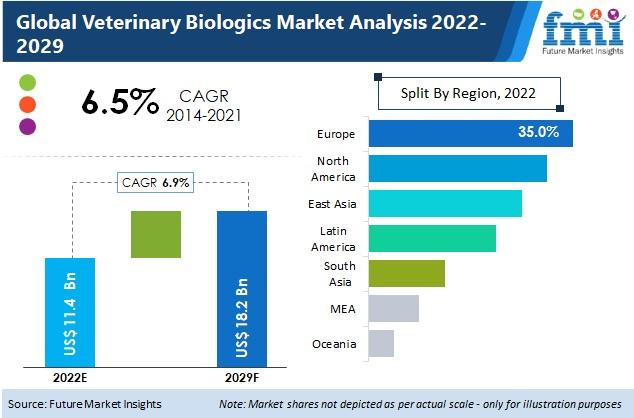A recent market analysis by Future Market Insights (FMI) projects that the global Veterinary Biologics Market will be worth US$ 11.4 billion in 2022 and US$ 18.2 billion by 2029.
Pet health concerns are on the rise due to the growing trend of pet ownership around the world, which is driving up demand for veterinary biologics. The American Pet Products Association (APPA) estimates that 67% of American households now have a pet, a considerable increase of 56% since 1988. The most common use of prophylactic veterinary biologics, such as vaccinations, is prevention.
Increase in usage of prophylactic veterinary biologics is primarily attributed to growing awareness about better pet health management and risk of various diseases such as rabies. Recently, the World Health Organization (WHO) endorsed the use of veterinary biologics such as monoclonal antibodies over blood-derived rabies immunoglobulin. Such endorsements and quest for more safe & effective veterinary biologics have resulted in increased R&D spending.
Ignite Your Passion for Learning with PDF Samples.@ https://www.futuremarketinsights.com/reports/sample/rep-gb-2288
Key Takeaways of Veterinary Biologics Market Study
- Owing to rapid adoption of vaccines as a prophylactic treatment for better herd immunity, the segment is expected to be a significant revenue generator.
- Growing adoption of monoclonal antibodies for dermal disorder treatment in companion animals is anticipated to contribute to the dominance of the segment during the forecast period.
- Rising prevalence of infectious diseases in livestock has boosted the demand for veterinary biologics. Livestock is expected to be a significant revenue generating segment by animal type, during the forecast period.
- By distribution channel, the veterinary biologics market is dominated by veterinary clinics in terms of revenue, owing to direct customer contact for bulk orders.
- Europe is anticipated to be the most lucrative region in terms of revenue, due to growing adoption of animals for commercial use. East Asia is expected to witness notable growth during the forecast period.
Mergers & Acquisitions Key Strategy of Veterinary Biologic Manufacturers
Manufacturers such as Boehringer Ingelheim International GmbH, Zoetis Inc., etc., are engaging in mergers & acquisitions with small and medium regional players in the veterinary biologics market in order to streamline their product offerings in respective regions with diverse product portfolios.
Connect with Industry Experts and Get Expert Advice.@ https://www.futuremarketinsights.com/ask-question/rep-gb-2288
More Valuable Insights on Veterinary Biologics Market
Future Market Insights brings a comprehensive research report on forecast revenue growth at global, regional, and country levels, and provides an analysis of the latest industry trends in each segment from 2014 to 2029. The global veterinary biologics market is segmented in detail to cover every aspect of the market and present a complete market intelligence approach to the reader. The study provides compelling insights on the veterinary biologics market on the basis of product type (vaccines, monoclonal antibodies, bacterial extracts, immunomodulators, and allergenic extracts), animal type (companion animals, livestock, and equine), and distribution channel (veterinary clinics, veterinary hospitals, veterinary research institutes, and retail pharmacies), across seven major regions.
Veterinary Biologics Market By Category
By Product
- Vaccines
- Attenuated Live Vaccines
- Conjugate Vaccines
- Inactivated Vaccines
- Subunit Vaccines
- Toxoid Vaccines
- DNA Vaccines
- Recombinant Vaccines
- Bacterial Extracts
- Monoclonal Antibody
- Immunomodulatory
- Cytokines
- Others
- Allergenic Extracts
By Animal
- Companion Animals
- Canine
- Avian
- Feline
- Livestock
- Aquatic
- Bovine
- Porcine
- Ovine/Caprine
- Poultry
- Equine
By Distribution Channel
- Veterinary Clinics
- Veterinary Hospitals
- Veterinary Research Institutes
- Retail Pharmacies
By Region
- North America
- Latin America
- Europe
- South Asia
- East Asia
- Oceania
- Middle East and Africa (MEA)

